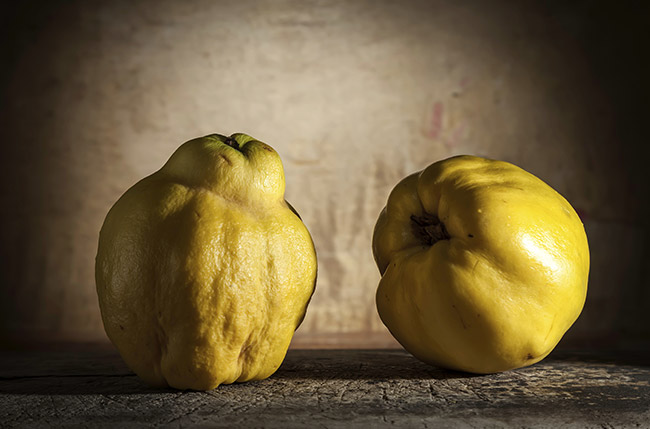
The quince is a fruit that is closely related to apples and pears, and it resembles a yellow, lumpy pear. Quinces have been utilized by people since ancient times, for instance, it is believed that the “apples” referred to in the Song of Songs in the Old Testament were quinces. The fruit is thought to be native to Iran and the Levant, and was known to the Akkadians in 2300 BC. Quinces were used in many applications by the Greeks who called them cydonia. The ancient Greeks used quinces in wedding ceremonies, and as part of religious rituals, particularly in fertility rites. They also prepared and preserved quinces in honey and called this concoction melimelon, meaning “honey apple.” The Greeks taught the Romans to make this preserve, and the Romans borrowed the Greeks’ word for it, but Latinized it as melimelum. This word survives today in Portuguese as marmelada, Italian as marmellata and in English as marmalade. The word quince evolved along similar lines over the centuries from the original Greek cydonia which was carried over by the Romans, and survives today in Latinate languages. In Italian, it is called cotogna, in French, coing. This word made its way into English at least as early as Chaucer’s time, around the mid-fourteenth century. Chaucer makes mention of quinces, commonly using the Middle English cognate, coines, in a long poem entitled Romaunt of the Rose, and he used the more modern quince in a short, bawdy poem called O Mosy Quince. The quince was known and used throughout the ages by many different cultures. Today, the fruit is used in a wide variety of dishes, sweet and savory, traditional and modern.
Quinces cannot be eaten raw due to their sourness and toughness. Once cooked, quinces become sweet, but very tart. The sweet tanginess of the fruit has made it a popular ingredient in pies, tarts, traditional marmalade and candies, especially in the United Kingdom. Although quinces were considered a staple in the American kitchen long ago, they are now considered a specialty item. Quinces are becoming popular once again in the U.S., especially as a tangy addition to apple pie recipes. Simply replacing one third of the apples in your apple pie recipe with slices of quince can take your pie to a whole new level. An easy, vibrant dessert can be made by poaching quince in honey. Although quinces are known primarily for their uses in desserts and preserves, they are also used in traditional Middle Eastern, Persian, Moroccan and Mediterranean dishes, where they are often stewed with lamb and pork. Due to their high pectin content, quinces are great candidates for pies and preserves, and they can lend a great deal of flavor and tanginess to savory, slow cooked recipes.
Unripe quinces are very hard and have green skin. As the fruit ripens, the skin turns yellow, and will be slightly less firm to the touch. Quinces can be left safely at room temperature to ripen, but once they turn yellow, they should be refrigerated, and will last up to two weeks. When preparing the quince, slice the fruit in half vertically, and remove the core. The skin is edible, but can be removed if desired. As with apples and pears, the flesh of the quince will quickly brown when exposed to the air. This doesn’t affect the flavor, and the fruit turns a deep red hue once cooked, so don’t be concerned if the flesh browns. The skin of the fruit can sometimes be covered in a thin, soft wool-like substance, but this is nothing to worry about. Either wash this away, or remove the skin entirely.


 BACK TO PRODUCTS
BACK TO PRODUCTS